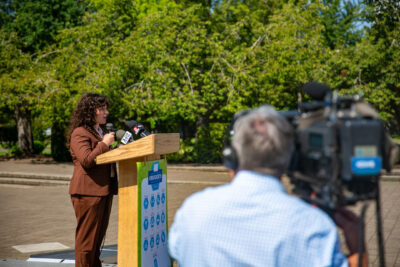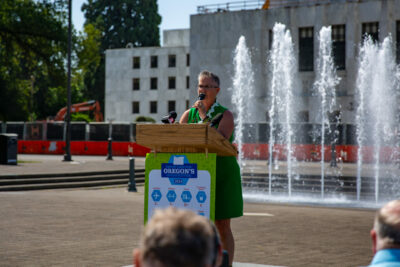
On Tuesday, August 6th, the Oregon section of the American Society of Civil Engineers (ASCE) released the 2024 Report Card for Oregon’s Infrastructure outside the State Capitol Building in Salem. Oregon’s infrastructure received a grade of ‘C-’, which is the same grade the Beaver State’s infrastructure received on its 2019 Report Card. This grade also matches the national infrastructure grade from the 2021 Report Card for America’s Infrastructure.
Seven of the 12 categories evaluated in the Oregon Infrastructure Report Card received grades higher than the National Report Card. Two categories (energy and wastewater) received the same grade as their national counterparts, while two other categories (bridges and ports) have a grade lower than the national average. Oregon’s schools received an incomplete grade due to a lack of current data on school conditions.
| Grade | Infrastructure Categories |
| C | Drinking Water, Inland Waterways, Roads |
| C- | Aviation, Bridges, Energy, Ports |
| D+ | Dams, Stormwater, Transit, Wastewater |
| I | Schools |

ASCE President Marsia Geldert-Murphey, P.E. attended the release event and spoke about the importance of infrastructure investment at all levels – highlighting the findings of ASCE’s Bridging the Gap Economic Study, which was released earlier this year.
Attendees also heard from Ron Stillmaker, the President of Professional Engineers of Oregon, Oregon State Representative Mark Gamba, Oregon State Senator Aaron Woods, and 1,000 Friends of Oregon Transportation Policy Manager Cassie Wilson.
The State of Oregon’s Transportation Infrastructure
Oregon’s roads received a ‘C’ grade, while bridges received a ‘C-’, both of which are a one-step grade decrease from the 2019 Report Card. The percentage of state highways in poor condition grew from 10 percent in the 2019 Report Card to 12 percent in the 2024 Report Card. During the same time, the number of roads in good condition decreased from 65 percent to 58 percent.
Oregon has made some progress in reducing the number of bridges in poor condition from 5.2 percent to 4.8 percent. However, there is a growing number of bridges that have been downgraded from good to fair condition. Many bridges in Oregon are also close to or exceeding their design life, with 53 percent of bridges in the state more than 50 years old. Current funding levels for bridge maintenance provide only about half the projected need to keep the state’s bridges in their current condition.
While the “Keep Oregon Moving” law passed in 2017 has funded more than 140 transportation projects over the last few years, the state anticipates 2024 is the final year the state will see an increase in gas tax revenues which help fund road and bridge construction, and the Oregon Department of Transportation anticipates having a $720 million budget deficit by 2027 unless long-term funding solutions are put in place.
The State of Oregon’s Water Infrastructure

Oregon’s drinking water grade increased from a ‘C-’ to a ‘C’ in the 2024 Report Card. More than 99 percent of the state’s drinking water systems meet standards for safe drinking water set by the Environmental Protection Agency (EPA). However, more than 400,000 Oregonians rely on private water sources like wells which are largely unregulated.
As water systems prepare for a new rule that requires the removal of lead service lines, the EPA estimates Oregon has approximately 3,350 lead water service lines, which is 0.04 percent of all lines in the state. That number is low because many of Oregon’s water pipes were installed in the last 50 years when utilities started using other materials for water service lines. However, other parts of the state’s water infrastructure are much older and will need to be replaced or upgraded to meet current needs.
Additionally, water utilities also face new costs as they comply with rules requiring them to monitor for dangerous forever chemicals in drinking water. The Report Card estimates Oregon’s drinking water systems need $10 billion in additional funding over 20 years to ensure the state has safe and reliable drinking water.
How Resilient Is Oregon’s Infrastructure?
The Oregon Infrastructure Report Card found that almost all infrastructure systems need improvements in their resilience to combat the effects of climate change and earthquakes.
Much of the state’s infrastructure was built before modern seismic codes were adopted, which means those systems will likely see extensive damage should a large earthquake hit the state before retrofits are completed. Oregon’s dams received a ‘D+’ grade in part because nearly two-thirds of the state’s dams are more than 50 years old and are not built to withstand a strong earthquake or the stronger, more frequent flooding conditions communities are now experiencing.
The state’s energy infrastructure, which received a ‘C-’ grade, also has resiliency needs that must be addressed to ensure it can withstand a seismic event. The Oregon Infrastructure Report Card found that much of the state’s energy distribution network would also suffer extensive damage from a large earthquake, which would lead to extended outages and a prolonged recovery.
While state leaders have taken steps to improve the security and resilience of the state’s energy network by developing the Oregon Energy Security Plan, the improvements to ensure the reliability and redundancy of the energy network will require a large financial investment.
ASCE Recommendations for Oregon’s Infrastructure
The Report Card for Oregon’s Infrastructure also includes five recommendations to raise the state’s grade.
- Secure dedicated and sustainable funding sources to ensure long-term maintenance and improvement of Oregon’s infrastructure. This should focus on consistent long-term funding solutions rather than short-term influxes of money.
- Implement comprehensive resiliency measures for infrastructure systems against natural and man-made disasters. This should be a comprehensive, all-hazard assessment that evaluates the likelihood and consequences of a possible event. It should also look at mitigation strategies and address the recovery and return to service of infrastructure systems.
- Strengthen regulatory frameworks and enforcement to ensure the public safety and resiliency of critical infrastructure. This includes implementing Emergency Action Plans for high-hazard dams, Oregon Energy Security Plan recommendations, and new regulations requiring seismic vulnerability assessments and mitigations for large fuel handling facilities.
- Utilize asset management systems to optimize spending. These programs include life-cycle cost considerations, identifying and prioritizing critical system components, conducting condition assessments, and establishing operations and maintenance plans. This approach should prioritize essential repairs and replacement projects and include long-term capital budgeting.
- Address the skilled workforce shortage and increase public participation to support long-term infrastructure improvements and community engagement.
ASCE’s Oregon section will now use the new Report Card to advocate for infrastructure needs across the state at the local, state, and federal levels.
State Report Cards are a volunteer effort by expert engineers and infrastructure professionals. We’d like to thank every report card committee who worked hard to provide Oregonians with a comprehensive look at the state’s infrastructure conditions, needs, and a path forward to improving the grades.
2024 Report Card for Oregon’s Infrastructure Volunteers
REPORT CARD CHAIR
Ana Tijerina Esquino
RELEASE AND LOGISTICS SUPPORT
London Howell-Farley, Chris Knight, PE
AUTHORS/CONTRIBUTORS
Category leads are listed in bold
Aviation
Tom Peterson, PE (ret.) MASCE, Blaine Wruck, PE, Ana Tijerina Esquino Lindsi Hammond
Bridges
Hanmin Wang, PE, PhD, Josh Goodell, PE, Nan Hua, PE, PhD, M.ASCE, Shuchen Han, PE
Dams
Kayla Sorenson, Kelcy Ademec, PE, Liam Wallace, PE
Drinking Water
Bryan Batton, Robert Olney, Larry Magura, PE
Energy
Ana Tijerina Esquino, Robert Schomp, Blaine Wruck, PE, Tom Peterson, PE (ret.) MASCE, Allison Pyrch, G.E., P.E., Leon Kempner
Inland Waterways
Tom Peterson, PE (ret.) MASCE, Austin Deanhardt
Ports
Austin Deanhardt, Tom Peterson, PE (ret.) MASCE
Roads
London Howell-Farley, Blaine Wruck, PE, Levi Warriner, PE
Schools
Richard Steinbrugge, PE (ret.), M.ASCE
Stormwater
Andrea Boyd, P.E., Carrie Pak, P.E., Teresa Huntsinger
Transit
Perrin Falkner, PE, London Howell-Farley, EIT, Michelle Wyffels, Robert L. Lund Jr., PE
Wastewater
Todd Martinez, P.E., Ana Tijerina Esquino




